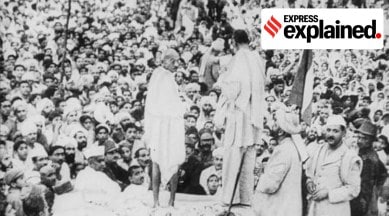Explained: Recalling ‘Quit India’, when ordinary Indians took to the streets with a vow to ‘Do or Die’
On August 9, 1942, the biggest mass movement of the Indian freedom struggle was launched. The British launched a brutal crackdown, but the message was clear: they would have to leave India, nothing less was acceptable

On this day 80 years ago — on August 9, 1942 — the people of India launched the decisive final phase of the struggle for independence. It was a mass upsurge against colonial rule on a scale not seen earlier, and it sent out the unmistakable message that the sun was about to set on the British Empire in India.
Mahatma Gandhi, who had told the Raj to “Quit India” on the previous day (August 8) was already in jail along with the entire Congress leadership, so when August 9 dawned, the people were on their own — out on the street, driven by the Mahatma’s call of “Do or Die”.
This truly people-led movement was eventually crushed violently by the British, but by then it was clear that nothing short of their final departure was acceptable to India’s masses.
Build-up to August 1942
While factors leading to such a movement had been building up, matters came to a head with the failure of the Cripps Mission.
With World War II raging, the beleaguered British government needed the cooperation of its colonial subjects. With this in mind, in March 1942, a mission led by Sir Stafford Cripps arrived in India to meet leaders of the Congress and the Muslim League. The idea was to secure India’s whole-hearted support in the war, and the return offer to Indians was the promise of self-governance.
But things did not go that way. Despite the promise of “the earliest possible realisation of self-government in India”, Cripps only offered dominion status, not freedom. Also, there was a provision for the partition of India, which was not acceptable to the Congress.
The failure of the Cripps Mission made Gandhi realise that freedom would come only if Indians fought tooth and nail for it. The Congress was initially reluctant to launch a movement that could hamper Britain’s efforts to defeat the fascist forces. But it eventually decided on mass civil disobedience. At the Working Committee meeting in Wardha in July 1942, it was decided the time had come for the movement to move into an active phase.
Gandhi’s address: Do or Die
On August 8, 1942, Gandhi addressed the people in the Gowalia Tank maidan in Bombay (Mumbai). “Here is a mantra, a short one, that I give you. Imprint it on your hearts, so that in every breath you give expression to it,” he said.
“The mantra is: ‘Do or Die’. We shall either free India or die trying; we shall not live to see the perpetuation of our slavery,” Gandhi said. Aruna Asaf Ali hoisted the Tricolour on the ground. The Quit India movement had been officially announced.
The government cracked down immediately, and by August 9, Gandhi and all other senior Congress leaders had been jailed. Gandhi was taken to the Aga Khan Palace in Poona (Pune), and later to Yerwada jail. It was during this time that Kasturba Gandhi died at the Aga Khan Palace.
The people vs the Raj
The arrest of their leaders failed to deter the masses. With no one to give directions, people took the movement into their own hands.
In Bombay, Poona, and Ahmedabad, hundreds of thousands of ordinary Indians clashed with the police. The following day (August 10), protests erupted in Delhi, UP, and Bihar. There were strikes, demonstrations and people’s marches in defiance of prohibitory orders in Kanpur, Patna, Varanasi, and Allahabad.
The protests spread rapidly into smaller towns and villages. Till mid-September, police stations, courts, post offices, and other symbols of government authority came under repeated attack. Railway tracks were blocked, students went on strike in schools and colleges across India, and distributed illegal nationalist literature. Mill and factory workers in Bombay, Ahmedabad, Poona, Ahmednagar, and Jamshedpur stayed away for weeks.
In some places, the protests were violent. Bridges were blown up, telegraph wires were cut, and railway lines were taken apart. On the 25th anniversary of the Quit India Movement, the socialist leader Ram Manohar Lohia wrote: “9th August was and will remain a people’s event. 15th August was a state event… 9th August 1942 expressed the will of the people — we want to be free, and we shall be free. For the first time after a long period in our history, crores of people expressed their desire to be free…”
The slogan ‘Quit India’
While Gandhi gave the clarion call of Quit India, the slogan was coined by Yusuf Meherally, a socialist and trade unionist who also served as Mayor of Bombay. A few years ago, in 1928, it was Meherally who had coined the slogan “Simon Go Back”.
Brutal suppression of protests
The Quit India movement was violently suppressed by the British — people were shot and lathicharged, villages were burnt, and backbreaking fines were imposed. In the five months up to December 1942, an estimated 60,000 people had been thrown into jail.
However, though the movement was quelled, it changed the character of the Indian freedom struggle, with the masses rising up to demand with a passion and intensity like never before: that the British masters would have to Quit India.